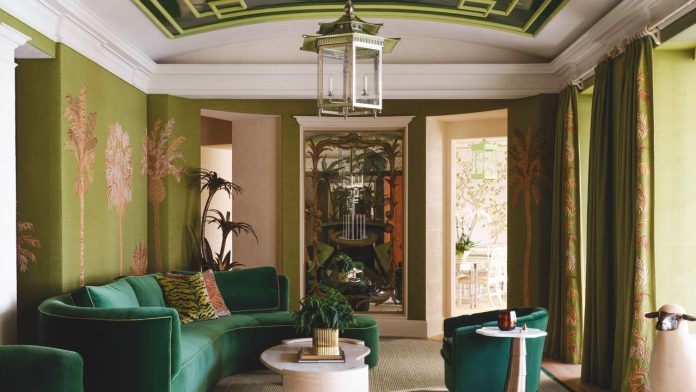Presented by Marvin
In 2026, interior design is doubling down on self-expression. Our AD100 and AD PRO Directory members emphatically agree that the era of pared-back, monastic spaces ruled by neutral hues is over. We’re predicting more maximalism, more saturated shades, and more homes that put personality on full display. Eclecticism is in, and being built with warm, textured layers of color, pattern, and ornamented detail.
In this member-exclusive trend report, we explore the movement defining the year ahead. Personalized tilework is on the rise; old-world trimmings and passementerie are back in style; hyper-specific at-home amenities are building wellness routines into everyday living. Read on for the full industry outlook—and get ahead of the trends shaping design’s next chapter.
All the Extras: Trimmings Return With a Vengeance
Passementerie and elaborate old-world drapery is back. Designers tell AD PRO how they’re embracing tassels, fringe, cording, and other ornaments
Not long ago, “clean-lined” was the design industry buzzword. No more: In the latter half of the 2020s, interiors are embracing a more-is-more mentality, where no cushion is complete without tufting, no curtain lacks a tassel, and every sofa seems to beg for a sweep of silk fringe. To achieve this look, designers are applying classic decorating techniques—passementerie, elaborate drapery and traditional upholstery methods—with a contemporary twist. To assure these old-school techniques feel fresh rather than fussy, AD PRO asked designers how they’re reimagining them for today.
Create contrast with cording
Cording typically plays a supporting role in upholstery, quietly finishing seams and edges. But designers are increasingly using it as a statement element. For the New York City home of Zooey Deschanel and Jonathan Scott, AD100 designer Young Huh collaborated with workroom Stitch NYC to apply a zigzag of contrasting gold cording to the home’s centerpiece living room sectional, alongside fringe and tufting. Without these details, the armless, generously proportioned piece would read entirely contemporary. “A sectional is a modern idea,” Huh said in AD’s November 2025 issue. But with an inventive application of ornate extras, she “made it feel old-world.”
San Francisco–based AD PRO Directory designer Noz Nozawa says she likes incorporating cording in her custom upholstery projects, which “contribute texture and color in ways that invite you closer.” In her own living room, for example, the designer refreshed a bergère with a geometric-patterned fabric and outlined its form with crimson double welting.
“I feel like there can never be enough stripes or fringe or tassels in a house!” Emma Roberts declared in her Open Door video last year, as she toured AD through her Pierce & Ward-designed “grown-up dollhouse.” (Her Los Angeles home included not one, but two pairs of lamps with fringe-trimmed shades.) If the fringe movement was nascent in 2024, it’s now reaching maturity, adding movement to elegant contemporary furnishings.
On New York City’s Upper East Side, AD100 Studio Valle de Valle designed a double-sided sofa for an Ulla Johnson boutique. Not content with a single layer of fringe along the base, the studio doubled it for amplified impact. In Kate Rheinstein Brodsky’s family duplex, a velvet-covered borne settee in the living room sports a Samuel & Sons bullion fringe in split pea green—a color that firmly grounds the historically shaped piece in this era.
“Color scheme and motif bring fringe into today,” explains Adam Greco of New York design studio GrecoDeco, who recently embraced an array of fringe, tassels, and drapery for Villa Inkognito, a boutique hotel in Oslo, Norway. For clients hesitant to commit, Liam Dublin, director of AD PRO Directory firm Post Company, suggests starting small. “Reupholster a chair—or even part of one—in a contrasting fabric and add fringe along the base,” he says. “Small gestures like these introduce texture and detail without going over the top.”











